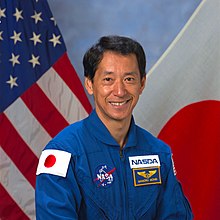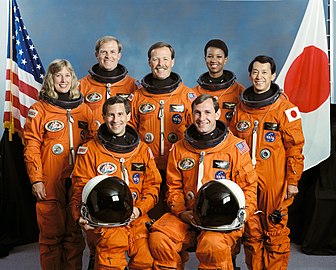cosmos.wikisort.org - Cosmonaut
Mamoru "Mark" Mohri (毛利 衛, Mōri Mamoru, born 29 January 1948), AM is a Japanese scientist, a former NASDA astronaut, and a veteran of two NASA Space Shuttle missions. He is the first Japanese astronaut who was part of an official Japanese space program. The first Japanese person in space, Toyohiro Akiyama, was a journalist who was trained in the Soviet Union.
This article may be expanded with text translated from the corresponding article in Japanese. (October 2020) Click [show] for important translation instructions.
|
Mamoru Mohri | |
|---|---|
 Mohri in 2000 | |
| Born | 29 January 1948 Yoichi, Hokkaidō, Japan |
| Status | Retired |
| Nationality | Japanese |
| Occupation | Engineer |
| Space career | |
| NASDA Astronaut | |
Time in space | 19d 04h 09m |
| Selection | 1985 NASDA Group |
| Missions | STS-47, STS-99 |
Mission insignia | |
| Scientific career | |
| Fields | Materials science |
| Thesis | Physical adsorption on metals. (1976) |
Biography

Born in Yoichi, Hokkaidō, Japan, Mohri earned both a BSc and MSc degree in chemistry from Hokkaido University in respectively 1970 and 1972, and a PhD degree in chemistry from Flinders University in Adelaide, South Australia, in 1976.[1]
Most of Mohri's work has been in the field of materials and vacuum sciences. From 1975 to 1985, Mohri was a member of the nuclear engineering faculty of Hokkaido University, where he worked on nuclear fusion-related projects.
Mohri was selected by the National Space Development Agency of Japan (now JAXA) to train as a payload specialist for a Japanese materials science payload. He flew his first space mission aboard STS-47 in 1992 as chief payload specialist for Spacelab-J. Mohri subsequently made another trip into space as part of mission STS-99 in 2000.
As of 2001, Mohri is the Chief Executive Director Emeritus for the Miraikan, the National Museum of Emerging Science and Innovation in Tokyo.
Honours
On 16 March 2006 Mohri was appointed an Honorary Member of the Order of Australia (AM), “for service to Australia-Japan education and science relations.”[2]
Gallery
- Gallery
- Mamoru Mohri being fitted for a spacesuit and conducing an experiment in space aboard STS-47
 Astronaut Mamoru Mohri on Endeavour's flight deck during STS-99 Flight Day 4 of the Shuttle Radar Topography Mission (14 February 2000)
Astronaut Mamoru Mohri on Endeavour's flight deck during STS-99 Flight Day 4 of the Shuttle Radar Topography Mission (14 February 2000)- STS-47 Endeavour, crew members with Mamoru Mohri
- STS-47 crew in SLJ make notes during shift changeover
External links
- "MOHRI Mamoru biography". JAXA. Retrieved 25 July 2021.
- Spacefacts biography of Mamoru Mohri
References
- The Earth "MAHOROBA" - Astronaut Mohri's STS-99 Earth Observation Mission - website of JAXA
- It's an Honour Archived 29 January 2019 at the Wayback Machine. Itsanhonour.gov.au (2006-03-16). Retrieved on 2011-06-24.
На других языках
[de] Mamoru Mōri
Mamoru Mōri (jap. .mw-parser-output .Hani{font-size:110%}毛利 衛, Mōri Mamoru; * 29. Januar 1948 in Yoichi, Hokkaidō, Japan; in den USA bekannt als Mamoru „Mark“ Mohri) ist ein ehemaliger japanischer Astronaut. Er war Teilnehmer zweier Space-Shuttle-Missionen der NASA.- [en] Mamoru Mohri
[fr] Mamoru Mōri
Mamoru Mōri est un spationaute japonais né le 29 janvier 1948.[it] Mamoru Mōri
Mamoru Mōri (毛利衛 Mōri Mamoru?; Yoichi, 29 gennaio 1948) è un ex astronauta giapponese.[ru] Мори, Мамору
Мамо́ру ‘Марк’ Мо́ри (яп. 毛利 衛 Мо:ри Мамору, род. 29 января 1948) — первый профессиональный японский астронавт, доктор наук по химии; выполнил два полёта на космическом челноке «Индевор» (1992, 2000).Другой контент может иметь иную лицензию. Перед использованием материалов сайта WikiSort.org внимательно изучите правила лицензирования конкретных элементов наполнения сайта.
WikiSort.org - проект по пересортировке и дополнению контента Википедии


